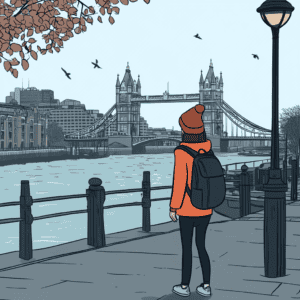Hometown Glory?: What is University College London Like?

- Originally published
- Last updated on February 17th, 2024 at 08:42 pm
Table of Contents
University College London (UCL) is one of the Uni of London constituent schools, but you’ll hardly notice you’re allowed to use all those other libraries, because UCL itself is a large university, an international hub, and has plenty to offer students on its own. But we still wondered, “what is University College London like?”
We wanted to know what kinds of students thrive there, and what it’s really all about. There are a ton of “lookalike” schools in central London, all vying to be academic powerhouses for international students. How does this one look different? What makes it special? Who loves it? Who hates it?
We asked a ton of current students and recent grads about what they wish they knew before attending, and put it all together so you can get a feel for whether UCL is in your “yes” or “no” list before you blow a UCAS spot on it.
Ultimately, UCL is a gigantic, and somewhat anonymous spot to grab a globally prestigious degree, network your butt off, and meet people that will change your life. It’s also a pricy option in a cultural hub in central London, where cost of living is as high as students’ ambitions. Let’s dig into one of the top 20 universities in the world.
University College London (UCL) Basics for Beginners
Degrees: BA, BSc, BEng, LLB, MSci, BASc, BEng, MEng, MPharm
Majors: Top ten programs, according to US News, in Arts & Humanities, infectious diseases, neuroscience and behavior, pharmacology & toxicology, education and educational research, gastroenterology & hepatology, psychiatry/psychology, public health, radiology, surgery, and public health. With an insane breadth of language degrees, UCL can be a place to get your global feet wet. It’s better known for sciences and economics, though you may feel more at home studying for the only available undergraduate degree in Icelandic (outside Iceland, that is).
Location: London City Center, London
Cost for international students: £28,100 for library-based BA programs like English, Dutch, Italian, or Icelandic. £37,500 in brain sciences for programs like psychology. £31,100 in fields in the “build environment” like architecture and engineering & architectural design. But straight engineering programs are £37,500, along with math, data science, sciences, and economics fields. Social sciences and medical programs are £34,400.
On-campus housing cost: £145 weekly for a single room without a bathroom ($5,655 for the 39-week academic year). Rooms are limited in the sub-£200/weekly price range. Some university single rooms with a bath run £300/weekly (totalling £11,700 for the academic year).
FAFSA Funds: Yes, look for “University of London — University College London.”
Abroad from abroad: Yes, and the program is encouraged with on-campus sessions on volunteering as well as study opportunities. Short-term as well as year-long study abroad placements are possible. Some programs are competitive. “Go Abroad Week” in the fall can help you hone options.
Student body: 51,0058 students, about half of whom are undergrads. At the undergraduate level, you’ll find 11,700 international students who hail from 150 countries, but the university overall boasts a 48% international student rate and thinks of itself as “London’s Global University.”
Five adjectives: driven, worldly, cosmopolitan, balanced, curious
Undergraduate in Bloomsbury: What’s it Like?

The Bloomsbury district in central London was once known for its famous literary group. While you can’t hang with Virginia Woolf today, you can stroll the opulent townhouses and the green, leafy streets that still reverberate with the echoes of T.S. Elliott, William Butler Yeats, and the Bloomsbury artists.
And you can call this hyper-urban University College London neighborhood home. Today, the area still offers a bustling, culturally rich slice of London, anchored by multiple universities, with niche delights like the Egyptian Archaeology Museum and the Grant Museum of Zoology (under whose founder Charles Darwin studied evolution). Close by, check out the gargantuan British Museum as well as the Wellcome Collection, where you can explore fascinating modern exhibitions on topics like the history of beauty.
While you’re there, get some homework done in the groovy reading room (you’ll surely be inspired by Beethoven’s life mask or the 1920s X-ray machine on display) or the museum’s airy café.
Needless to say, Bloomsbury is still a corner of London that seems to call scholarly newcomers to mingle, develop avant grade ideas, and eventually, start their own literary salons. It’s an upscale area dominated by cultural offerings and students, in a compact campus area, which can help students feel like they’re “in their bubble” in spite of the urban location.
UCL is in a very collegiate district while also being in the center of London. I appreciate little campus places, like walking through the tunnel under the Medical Sciences Building and working at the outdoor café.
Bloomsbury is also chock full of parklike Georgian squares from which burnt-out students can plop down on a bench and try to spot one of London’s wandering red foxes, or meet students from nearby Birkbeck and SOAS constituent universities of the University of London (where UCL students can access library collections and facilities).
Gordon Square is enveloped by campus buildings and sports a weekly farmer’s market where students can grab a chai, a giant pretzel, and a slice of moussaka on their way home from class. Don’t worry if you don’t have a kitchen in your dorm, or if the refrigerators are raided by other students. There are oodles of prepared food from local restaurants where you can get something warm and delectable to get you through exam week.
One block over, Tavistock Square offers views of the Georgian townhouses that Charles Dickens once contemplated while writing A Tale of Two Cities. A couple of blocks to the south, Russell Square is even more expansive, and a relaxing spot to feel the warmth of the winter sun from the glass-lined coffee shop. Sitting outside watching squirrels run amok, you’ll be hard pressed to feel you’ve chosen to study in the “concrete jungle” that might otherwise describe central London.
Nearby Neighborhoods and Places to Hang
But of course, this is central London. A few blocks north, you can wander into Camden for indie music and all the fishnet tights and neon rave-wear you’ll ever need for clubbing. You can walk to the British Library to see original Beatles manuscripts. Head over to Brunswick Center for outdoor boutiques and eats, with occasional live music. We think its claim to fame is the highest-rated bubble tea in the neighborhood at Truedan.
You can also walk 15 minutes to St. Pancras or King’s Cross train stations and head anywhere in England (or even through the Channel Tunnel to France). Dickens could have hardly known that today, his neighbors could experience both cities in his tale before lunchtime.
Multiple student nights beckon students with cheap drinks (a holy grail in pricy London). Head to Roxy’s on Monday night, the Loop for Sports Night on Wednesdays, and the student union bars (there are four) when you’re looking to save cash. After all, learning the £1 cover charge bars with student nights is practically a class at UCL, since London covers of £20 or more is pretty typical. Sop up all that alcohol with a hot dog from Herman Ze German (you’ll have to get there by 11 pm). And don’t fear: there are curry and vegan options.
As the year wears on and local students chew up their student “maintenance” loans, house parties can eclipse student nights out. When that happens, you and your friends can scrimp even more by hitting up the discount grocery store, Lidl, just a couple of blocks from campus.
You can also save cash by venturing out to world-class, 24-hour party dens like Egg during university-sponsored events like the holiday ball and occasional raves for big savings, or before midnight on days when early birds get in free. Stay til 7:00 a.m. and drag yourself home, understanding why Durham students complain, “You won’t get London nightlife anywhere else.” But also know you’ll have to work on your budgeting skills to keep your partying affordable.
When it’s warm, taking a bottle of wine and a picnic to Regent’s Park is truly magical.
LGBTQIA+ students (and those who prefer quiet reading to late-night DJs, can hit up Gay’s the Word, the only gay-specific bookstore in the UK. Brunswick Center, full of outdoor shops and eat, can also make a great weekend out.
In short: you’ll never run out of things to do in worldly London, where all sorts of students from all walks of life can find their place.
Safety in London for International Students
That doesn’t mean all students feel safe in this global city. London’s crime rate certainly outstrips smaller UK cities. With roughly 100 crimes per 1,000 residents, one study’s 1-in-20 UCL crime victim rate seems to suggest UCL students are far safer than the city’s other residents. Violent crimes are only about 25% of total crime.
What does any of that mean? It’s about double the crime rate of New York City, where you have a 1 in 26 chance of becoming a victim, and a smaller percentage of total crimes being violent. Huge controversies exist about London’s safety versus places like New York given reporting differences, differences in the definitions of crimes like sexual assault, and general safety vibes. However, it’s clear that crime in London is far less deadly than in large US cities. One student asserted that London, and the university community, encourage reporting of otherwise underreported crimes, which police take seriously, and in turn, shows the city is a safer city, not a more dangerous one.
High reporting might be about having a higher crime rate, but I think it is about having a safe city where crime is taken seriously. This is especially important when it comes to crimes that are common among students, like sexual assaults.
While we couldn’t find evidence of world-leading initiatives to destigmatize sexual crime reporting in London more than elsewhere, this student may be on to something: one study has found that London is the world’s safest global city for women. And UCL buildings are all secure, front and back, with keyed entry and security guards that ensure only students and staff access university spaces.
The vibe in London may also feel safer for US students of color. The UK’s been called one of the least racist countries in the world because 98% of Brits say they wouldn’t mind living next to someone of a different race. That’s probably because they already do. London is just over 53% white according to the 2021 census.
There are plenty of Londoners with heritage from all over the world, from black Africa to the Caribbean, India, China, Arab, Bangladeshi, Japanese and more. London’s multiculturalism is a point of pride, with 88% of Londoners boasting that their city is the most multicultural in the world.
That expansive worldview pervades the vibe of UCL: it’s big, it’s comprehensive, and it mirrors London itself as a global juggernaut with something for everyone…as long as you don’t get lost in the crowd.
The Multicultural Campus at UCL
Other Campuses of UCL
While most students look forward to attending London’s central campus, UCL has a brand new East London campus as well as facilities in Doha, Qatar. UCL East boasts 23 acres with schools of design and engineering meant to grow into an innovation hub. With new buildings opened in 2022 and 2023, the east campus will eventually accommodate 4,000 students. For now, it’s mostly postgraduate programs, but the media BA will move from central London to the east campus this year.
In Doha, UCL’s small campus graduated just 330 students from 2010 to 2020, in specializations heavily concentrated in conservation, archaeology, and museum studies.
Even business students can get out of central London sometimes, with courses available at Canary Wharf ’s School of Management location. It comes with panoramic views across the city, but not all courses hold classes here.
Facilities and Buildings at the Bloomsbury Campus
Back on the Bloomsbury campus is still where much of the action resides, where most students apply to the UCL in central London. Even with development at new campuses, Bloomsbury is still the crown jewel of UCL, and comes with with world-class facilities. In the last 5 years, the architecture building got a “deep retrofit”. It doubled its capacity, while the new Faraday Laboratory opened to help UCL expand its work on electric car batteries and other energy projects.
Regardless of major, students appreciate the new £67 million student center, with its rooftop terrace and shady interior courtyard. Nineteenth-century philosopher and university icon Jeremy Bentham sits inside its new recesses, so if you’ve not heard about his unusual presence, read up on how his preserved body remains on campus before you’re startled by his lingering presence. London university lore says that his preserved head was once swiped by rival students and at other times, kicked around campus like a soccer ball. Currently, Jeremy sports a wax replica (the real thing lies in the archives of the archaeology department).
In the Student Center, you’ll also find student support and wellbeing, oodles of study spaces made to alleviate crowding in hotspots like the library), and a clean, modern café with vending machines.
The university’s Wilkins Building, lovely inside and out, is UCL’s primary Instagram attraction. The Neoclassical edifice was designed by the same architect as London’s National Gallery, and both are similar stately buildings with imposing domes. With its wall of columns, UCL’s library gets adorned with rainbow colors for Pride and crowded with students lounging on its steps in the evening. It also houses the main library, making it the main campus hub.
Don’t get the Walking Building confused with the Senate House Library, which reminds us of an imposing US post office in a large city. Its white columns harken students to levels upon levels of study resources, too, but George Orwell used this building as inspiration for his dystopian novel, 1984, since it served as the Ministry of Information during WWII.
Other university buildings blend into the cityscape. Students heading to campus pop out of the Euston Square underground station, pass the enormous University hospital, and may barely recognize university buildings, which are occasionally marked with the busts of famed scholars. You’ll find commuters, buses, and electric scooters whining by, all enveloping students in the larger London scene. UCL is not a campus university, and students looking for a sequestered experience in Student-ville will not be wowed by UCL.
UCL is a huge university in a huge city, so you get to meet people from all over the world. There’s a range of nationalities here. There’s just so much to experience you’ll never get around to seeing and doing everything.
It’s only in the center of campus that you’ll start to feel London fall away and students begin to dominate. However, students still say they feel the temptations of London is the best and worst thing about life at UCL: they’re never far from food trucks, pop-up shops, theaters, and the allure to spend cash and enjoy everything around them. Could be worse, eh?
Student Accommodation at UCL
Housing is less of an issue in central London than in smaller towns in England, and a huge bonus to attending a central London university, though prices in the capital remain the highest in the country. With weekly student dorm prices above £300, UCL accommodation can come with a helping of sticker shock to claim a spot in one of its 17 different student housing sites.
Further, housing is guaranteed to newcomers their first year. And students gush about the newest accommodation. Certainly, clean, mod halls have some advantages over their older counterparts: outdoor courtyards, big screen tvs in clean common rooms, great WiFi and insulation….all of which can make a world of difference after a long day in a cold library. Try Astor or St. Pancras, which can be the most popular dorm choices. Be forewarned: none of the building facades at UCL scream “homey.”
UCL students don’t seem to make as many friends through accommodation. Maybe that’s just me. But there are a couple of accommodations that have a reputation for having a social vibe. Many others no one’s heard of and it can be hard to find people in your course who are also in your accommodation, so sometimes it is just luck if you socialize in halls.
Some accommodation can be far afield from classes, too. That’s typically not a problem in London’s well-connected streets, but not everyone wants to commute via subway every morning and return home at night.
Campbell House East, Campbell House West, and John Adams, offers less mod blue carpets, but comes inside a centrally located Georgian row house, so you can play the part of a stylish Bloomsbury student. John Adams has some truly gorgeous rooms, with moulding, old fireplaces, and top-floor views to die for, all right on campus and with some lower-cost room options, like £202 weekly (totaling about £7,800 for the school year). That’s about as cheap as UCL accommodation comes. Consider that the communal kitchens won’t be secure places for refrigerated supplies, and you’ll need to budget for eating out much of the time, too.
There are just two “catered” housing options for students who prefer a meal plan. Ifor Evans, a mid-rise dark brick block building a bus ride away in Camden. It’s inconvenient and students describe it as dreary. It’ll take you about an hour to walk to campus, but you’ll get sympathetic looks from other students the whole way. On the bright side, catered halls include 12 meals per week (breakfast and dinner on weekdays and brunch on weekends).
At Ramsay Hall, a shared, room with hallway bathrooms and catered meals can save costs (it’s still £208 weekly). You can even opt for a larger studio that’ll set you back £317 weekly (£12,363, extraordinarily high for student housing). It’s another mid-rise brick cube, but this time, it’s just a few blocks from the heart of campus.
Dorms can be all over the map at UCL, so don’t assume they’re clustered near classes and you’ll need to consider the trade-offs of a great hall versus how easily you can get to class. You could even get offered a spot at the UCL East campus, though students should note that the fastest way back to central London, via tube, can mean accumulating fares up to another £200 monthly.
Going off campus in years 2 and 3 is the norm, and private student housing is just as expensive as homes managed by the university. But at least you’ll likely share a theft-free kitchen with friends, where cooking and hanging out can become an awesome part of the uni experience.
Academics and Student Life for International Students at UCL
Student Outlook and Satisfaction
Ever since its days as the university was founded in order to admit students of all faiths, UCL students have been “The Godless of Gower Street.” They never even had a theology department. UCL was also the first UK university to admit women on the same terms as their male counterparts. All that trailblazing has remained in the DNA of the university’s current vision.
Today, if getting ahead were a sport, UCL would be in the finals. That can have positive and negative implications. Students here are an ambitious bunch, often dedicated to their future careers and making their mark on society. If it’s true that British students are more likely than Americans to see university not as a “ride or die” part of their identities, but as a stepping stone to their future careers, then UCL is an exemplar of British university life.
While you will meet students who relish UCL, you’ll also meet a lot of students who want to attend for the line on their resumés that UCL gives them and have their sights set on their post-UCL lives. They’re excited that world-leading research is happening at UCL. Yet many wind up disenchanted that their professors see research, not teaching, as their “primary” vocation.
The result? UCL’s student satisfaction scores trail other UK universities. The National Student Survey finds satisfaction scores in Economics and Business with Eastern European Studies is a dismal 31%, far short of the national average of 83%, while UCL rates 49th for student satisfaction in another study.
Why are students dissatisfied? Some said that UCL lecturers and tutors can be outstanding, but that they don’t get enough of it. They cited low professor face time hours, too few lectures overall, little ability to engage during lectures, and that they were left too much on their own both in and out of the classroom.
I feel like UCL is very large, and that doesn’t leave room for personalization. It’s good learning from well-known experts. We had one particular class where all the research we read had come from UCL itself, and that was a a proud moment, like I was a part of that. But unfortunately, students aren’t really a part of that. They could be, but they’re not.
What is University College London Like for Classes? What Programs Stand Out?
UCL’s approach to teaching and learning isn’t much different from other English universities. You’ll sign up for classes, and if you have extra space in your schedule after mandatory classwork, you can choose an elective or two from a list of those accepted in your program. Lectures come with break-out discussion sessions, and grades are comprised of papers and final exams.
What is unique about UCL are breakout programs like arts and sciences (BASc), in which students can combine classes across arts, social sciences, and science. They’ll take a foreign language and declare a “pathway” through one of the three broad subject areas, but can otherwise pull together strings from across the university and weave them into something unavailable elsewhere.
Security and Crime Science students will also find a unique program at UCL, the first of its kind dedicated not to forensics but to preventing crime. Human Sciences is another unique offering that lets students dig into life sciences, albeit from the point of view of social sciences and history. Students study science modules like genetics and physiology, but combine them with classes on human ecology, history of science, and policy issues.
Students told us that in spite of the high caliber of academics at UCL, they attended in part because they thought the life/work balance here would be better than Oxbridge, and the excitement of London coupled with world-class professors was an unbeatable combo.
They stay true to those values once they get on campus.
UCL students are so supportive. I really don’t think there’s competition here. We all help one another in my course. The students are the best thing about UCL. There’s a WhatsApp group where you can ask questions and get feedback if you don’t understand something.
Sports and Societies at University College London
You can also find more like-minded UCL classmates by starting a workout routine or joining a student sport or society (a non-sport club).
The Student Union has a pay-to-play student gym that comes with perks like women’s hours, squash court rentals, and classes like yoga. There are even sports clubs and teams, divided into groups by skill level and competition: students can opt to hang out and try their hand at club sports, play others in intramurals, or join a team and compete against other universities.
While UCL’s sporty reputation is lukewarm, the opportunity to jump into social sessions for total newcomers is a cool aspect of UCL’s student life can be a great way to make friends and stay in shape. Go take a ball to the head in dodgeball. Learn the rules of canoe polo. Try to fly a glider. Club offerings can help students find a balance between academics and their new life in London.
If sports aren’t your thing, you’ll find 408 total clubland societies where you can explore your love of US law and politics, wilderness medicine, candle making, and even magic (enthusiasts should check out the nearby Magic Circle club for outstanding close-up magic shows and a small museum).
When it’s all over, UCL gets student kudos for career services, where students and recent grads can update their job applications, attend networking events, find out about research and funding opportunities, and stalk to a career consultant.
Overall, academics at UCL score big points, but students have even higher expectations. While they want to soar high, they’re also a supportive bunch for whom academic burnout is a dirty word, and for whom great teaching and life/work balance are integral to their university experience. In the end, UCL grads want to go on to great careers, and those who make use of UCL’s extensive network are most satisfied with their time at this bustling university.
Ready to Study at University College London? Here’s What You’ll Need to Apply
UCL doesn’t take direct applications, so international students should apply through UCAS, the UK’s centralized college application portal. Make sure you meet your department’s specific requirements.
Every student will need to submit 3 to 5 AP exams taken in grades 10 to 12, with needed scores ranging from 5, 5, and 4 to 5, 5, 5, 5, and 5 (or 5, 5, 5, 5, and an SAT of 1410 or an ACT score of 32). Note that GPA isn’t mentioned for international applicants straight out of high school.
You’ll submit grades, test scores, a letter of recommendation, and a personal statement by January 31 for fall entry.
Still Not Sure? Find your Perfect Vibe, Nightlife, and More
UCL is one university in a ton of London options. There’s King’s College London, LSE, and heck, even SOAS and Birkbeck for those committed to staying right in UCL territory.
Other options are Oxford and Cambridge, where you’ll reap the benefits of a world-class academic contender and still be within spitting distance of London. Not sure about London’s costs? Check out Durham, with a lower cost of living.
Don’t forget to bone up on the basics of College in the UK, from the differences in Scotland vs. England, and the low-down on the steps you’ll need to take to study in England.
Related Posts

Jessica Share
Jessica is the writer, Ph.D., and mom-of-an-abroad-student-in-the-UK at the helm of College Abroad Guides. When she's not asking college students where the coolest place to hang out in their city is, she's figuring out how she can make $60 imported Greek oregano potato chips and £50 British bacon potato chips appear on her doorstep for the cost of a local bag of Lay's.





